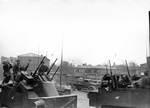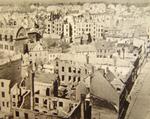East Pomeranian Offensive
Contributor: C. Peter Chen
ww2dbaseAs the initial phase of the East Prussian Operation was completed, Marshal Konstantin Rokossovsky's 2nd Byelorussian Front was redeployed to the Province of Pomerania in western Prussia. The main objective was to attack German forces in the region to eliminate a possibility of a counter-attack which might threaten Georgi Zhukov's 1st Byelorussian Front, which was on its way toward Berlin, the capital of Germany. German intelligence detected the preparations for such an attack as early as 13 Feb 1945, and on that information Colonel General Walter Wei├č of the seriously under-strength German 2nd Army requested to fall back toward Germany in the face of a strong Soviet attack, but the request was denied by Adolf Hitler.
ww2dbaseThe Soviet offensive began on 24 Feb 1945 with fresh troops of Kozlov's 19th Army, and the Germans were able to hold off the attack. On 26 Feb, the 3rd Guards Tank Corps and 3rd Guards Cavalry Corps took over the task of attacking the Germans (and Kozlov was relieved of command), taking Baldenburg and Neustettin by the next day. On 1 Mar, Zhukov's right wing, a grouping of the 3rd Shock Army, 1st Guards Tank Army, and 2nd Guards Army joined the attack on western Prussia. By 2 Mar, Wei├č's troops were completely cut off. On 4 Mar, Soviet tanks reached the Baltic Sea. Many German units were now encircled at various locations; those that are not fell back toward the city of Danzig. On 6 Mar, the Soviet 2nd Shock Army threatened to encircle Marienburg, which was evacuated two days later. To the east, Elbing fell under Soviet control on 10 Mar, a day after Wei├č was relieved of command for the defeats thus far. The new German commander, Dietrich von Saucken, led the German 2nd Army in a withdraw toward Danzig while Zhukov's forces decimated the remainders of the 3rd Panzer Army near the lower Oder.
ww2dbaseMany civilians fled into the coastal town of Kolberg, which was surrounded by 4 Mar. Colonel Fritz Fullriede had been in charge of German forces at Kolberg only since 1 Mar. He had under him a force consisted of local forces and the men from nearly destroyed units such as the 3rd Panzer Army, 33rd Waffen-SS Grenadier Division, and the 15th Waffen-SS Grenadier Division. The total number of defenders was about 8,000 to 15,000 with about 60 pieces of artillery and 18 tanks. From the sea, they had the support from the guns of L├╝tzow and Admiral Scheer. On the Soviet side, the first wave of attacks was conducted by Soviet troops (largely those of 45th Tank Brigade and 272nd Rifle Division) and the second Polish troops. (elements of Polish First Army, Polish 6th Infantry Division, Polish 3rd Infantry Division, and Polish 4th Infantry Division). The first wave of attacks on Kolberg began in the morning of 4 Mar, with troops entering the city at 0800 hours; the first troops were driven out of the city quickly. After four days of stalemate, the Polish troops were sent in under the command of Polish General Stanislav Poplavsky. The first attack during the Polish attack was repulsed by stubborn German defense while civilians and supplies were evacuated by sea, while the German warships provided effective naval gunfire support against Soviet tanks. Between 12 and 14 Mar, Polish troops and Russian tanks mounted a large attack, but it was driven back as well with heavy casualties on both sides. After some setbacks on 15 Mar, the German forces pulled back to the port on 16 Mar. On 17 Mar, most of the German troops and large number of civilians were successfully evacuated by sea to Swinem├╝nde. The city was declared secure by Polish troops on 18 Mar. At the end of the fighting, 80% of the city of Kolberg was destroyed.
ww2dbaseOn 15 Mar, Soviet troops marched toward the port city of Danzig, which was full of refugees seeking to escape to the west. By 19 Mar, Soviet troops reached the heights over Zoppot as German troops were pushed back into the city. On 22 Mar, the Russian 70th Army reached the sea and cut the German defenses into two. Gdynia was taken on 26 Mar as German defenders and civilians were evacuated to the Hel Peninsula. Danzig fell on 28 Mar, with remaining troops and refugees also heading toward the Hel Peninsula.
ww2dbaseThe Pomerania region was declared secure in early Apr, though German troops continued to fight from the Hel Peninsula until 10 May 1945.
ww2dbaseSource: Wikipedia.
Last Major Update: Feb 2009
East Pomeranian Offensive Interactive Map
Photographs
 |  |
East Pomeranian Offensive Timeline
| 13 Feb 1945 | German intelligence detected a Soviet build-up that suggested a move against the eastern Pommern and Danzig-Westpreu├čen region of Germany (occupied Poland and Danzig). |
| 15 Feb 1945 | German 11.SS-Armee launched Operation Sonnenwende in Pommern, Germany, although only III.SS-Panzer Korps started the attack on time. |
| 16 Feb 1945 | German 39.Panzer Korps and 10.SS-Panzer Korps began their parts of Operation Sonnenwende in Pommern, Germany. |
| 18 Feb 1945 | The German Operation Sonnenwende offensive in Pommern, Germany was halted by Soviet resistance. |
| 24 Feb 1945 | Soviet troops attacked toward the eastern Pommern region of Germany (occupied Poland). |
| 26 Feb 1945 | Soviet 3rd Guards Tank Corps and 3rd Guards Cavalry Corps took over as the main offensive force in the eastern Pommern region of Germany (occupied Poland). |
| 27 Feb 1945 | Z43 escorted ocean liner SS Hamburg to Sassnitz on the Jasmund peninsula on R├╝gen Island, Germany. |
| 27 Feb 1945 | Soviet troops captured Baldenburg (now Bialy B├│r, Poland) and Neustettin (now Szczecinek, Poland) in Pommern, Germany. |
| 2 Mar 1945 | Colonel General Walter Wei├č reported that his forces in the Danzig-Westpreu├čen region of Germany (occupied Danzig and Poland) were surrounded by Soviet troops. |
| 4 Mar 1945 | Soviet and Polish troops attacked Kolberg, Germany (now Kolobrzeg, Poland). |
| 5 Mar 1945 | Soviet 19th Army reached the Baltic coast, cutting off German 2.Armee in Pommern, Germany. |
| 7 Mar 1945 | Z43 escorted heavy cruisers Admiral Scheer and L├╝tzow from Danzig Bay to Swinem├╝nde, Germany (now ┼Üwinouj┼Ťcie, Poland). |
| 7 Mar 1945 | Soviet troops captured R├╝genwalde, Germany (now Darlowo, Poland). |
| 9 Mar 1945 | In eastern Pommern, Germany, Colonel General Walter Wei├č was relieved of command of failing to halt the Soviet offensive. He was replaced by Dietrich von Saucken. |
| 10 Mar 1945 | Over 25,000 civilians were evacuated from Kolberg in Pommern, Germany (now Kolobrzeg, Poland) by the Kriegsmarine. Meanwhile, Soviet 2nd Byelorussian Front attacked toward Danzig, taking Zoppot (now Sopot) along the way. |
| 11 Mar 1945 | Z43 began shelling Soviet positions near Kolberg, Germany (now Kołobrzeg, Poland). |
| 11 Mar 1945 | Soviet forces moved toward Gotenhafen (Gdynia) occupied Poland, endangering the civilian rescue effort there. |
| 12 Mar 1945 | Soviet and Polish troops launched a renewed assault on Kolberg, Germany (now Kolobrzeg, Poland). |
| 16 Mar 1945 | German forces began falling back from the front lines at Kolberg, Germany (now Kolobrzeg, Poland). |
| 17 Mar 1945 | German troops evacuated Kolberg, Germany (now Kolobrzeg, Poland) by sea. |
| 18 Mar 1945 | Z43 completed the shelling Soviet positions near Kolberg, Germany (now Kołobrzeg, Poland) as German forces completed the city's evacuation. |
| 18 Mar 1945 | Soviet 1st Polish Army captured Kolberg, Germany (now Kolobrzeg, Poland) while other Soviet units approached Gdynia and Danzig. |
| 19 Mar 1945 | Soviet troops captured the heights over Zoppot, Germany (formerly of Danzig; now Sopot, Poland) near the city of Danzig. |
| 26 Mar 1945 | Soviet forces captured Gotenhafen (Gdynia), occupied Poland, including the city's important shipyard and seaport facilities, although much of it were now damaged from sabotage and fighting. The harbor was now also blocked by a the sunken battlecruiser Gneisenau. |
| 27 Mar 1945 | Red Army fought fight their way into Danzig in the face of heavy resistance. |
| 28 Mar 1945 | Soviet 1st Byelorussian Front captured Gotenhafen (Gdynia), occupied Poland and Danzig (now Gdansk, Poland), yielding 9,000 prisoners of war. |
| 30 Mar 1945 | Soviet troops marched into Danzig, taking 10,000 prisoners of war and capturing 45 submarines. |
| 7 Apr 1945 | Heavy cruiser L├╝tzow, destroyer Z43, and other German ships completed the shelling Soviet positions on the coast of the Danzig Bay. |
| 5 May 1945 | Soviet 2nd Byelorussian Front captured Swinem├╝nde, Pommern, Germany (now Swinoujscie, Poland) and Peenem├╝nde Army Research Center, both located on the island of Usedom. |
| 10 May 1945 | The German resistance on the Hel Peninsula across the bay from Danzig, Germany (now Gdansk, Poland) ceased. |
Did you enjoy this article or find this article helpful? If so, please consider supporting us on Patreon. Even $1 per month will go a long way! Thank you. Share this article with your friends: Stay updated with WW2DB: |
Visitor Submitted Comments
8 Apr 2017 07:26:54 AM
My now deceased German father Hans J. Freybe joined the German Merchant Marine at 14 in 1940 after saying he was 17. In March 1945 he was aboard a small merchant ammunition and troop ship docked in Danzig/Gdansk when the Russians artillery started targeting his ship. He was 1 of 5 sailors who managed to get off the ship moments before artillery sunk it. The 5 found a small boat and managed to row out of the harbor under fire to the sea. They were picked up 5 days later by a German patrol boat and taken to Hamburg. I am trying to find the name of that ship. Can anybody assist? I'm a retired U.S. Navy Commander, Aviator and making my first visit to Poland in June 2017.
28 Mar 2018 04:19:52 PM
Actually Gotenhafen was Polish city. Before war it was called as today - Gdynia.
Before the war it was the youngest city in Poland it got city rights in 1926.
It is really interesting that its architeccture is so called "Warsaw modernism" (its architects were from Warsaw) and reminds some parts of Polish Capital (especially Stary Mokot├│w and Powiśle).
Polish citizens of Gdynia were forced by Germans to move away from there becase it was incorporated to Reich.
19 Nov 2019 09:24:34 AM
Has anyone got a rough estimate of the German dead, wounded and POW'S for the East Pomeranian offensive. Thanks in advance Mark.
All visitor submitted comments are opinions of those making the submissions and do not reflect views of WW2DB.
» Rokossovsky, Konstantin
Locations:
» Danzig
» Germany
» Poland
Ship Participants:
» Admiral Scheer
» Deutschland
» L├╝tzow
» Z43
Related Book:
» Atlas of the Eastern Front 1941-45
- » 1,146 biographies
- » 337 events
- » 43,435 timeline entries
- » 1,237 ships
- » 349 aircraft models
- » 207 vehicle models
- » 372 weapon models
- » 123 historical documents
- » 259 facilities
- » 468 book reviews
- » 28,402 photos
- » 432 maps
Joachim von Ribbentrop, German Foreign Minister, Aug 1939
Please consider supporting us on Patreon. Even $1 a month will go a long way. Thank you!
Or, please support us by purchasing some WW2DB merchandise at TeeSpring, Thank you!
1 Feb 2016 11:00:18 PM
So good